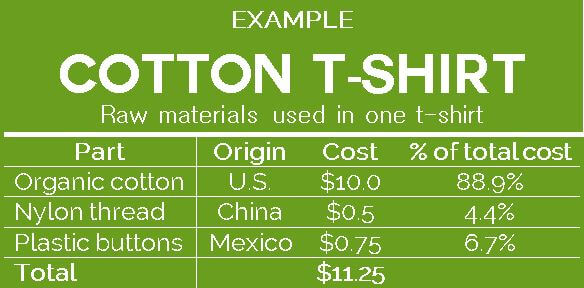Are you hesitant every time you read “Made in USA” in product labels? Do you trust such claims even knowing that many items we buy regularly are made abroad? We have talked about the virtues of Made in USA in the fashion industry, since we believe domestic production takes away some of the risks of operating in a cheaper country with weaker labor regulation, but what does a product need to have this phrase on its tag?
The following product categories are required to state the amount U.S. content:
 Textiles
Textiles
 Automobiles
Automobiles
 Wool products
Wool products
 Fur products
Fur products
No other product categories have to state U.S. content by law, yet many companies choose to do it given the claim’s marketable value. In either case, the same Federal Trade Commission (FTC) rules apply.
There are 2 ways of referring to a product as Made in USA:
– Unqualified claims: these are the most common type of statements and they simply say that the product is Made in USA without limiting that quality to a part or process, examples are:
– Made in USA
– Made in America
– Product of U.S. origin
– Our products are made in the United States
– Qualified claims: such claims specify the extent to which the product is Made in USA, for example:
– 70% U.S. content
– Made in USA with imported materials
– Assembled in USA with parts from China
– This product is made with fabric imported from Italy and cut and sewn in the US
The FTC states that to use the Made in USA claim, a product has to be all or virtually all made in the United States (50 states, District of Columbia and all U.S. territories). The key is the phrase “all or virtually all”, this means that all significant parts and processing that go into the product must be of U.S. origin.
In defining whether a part of process is significant, the following aspects are considered
Manufacturing location
Origin of the raw materials
Percentage of domestic vs. foreign raw materials
Proximity of foreign part or process to final product
As you can see, Made in USA doesn’t only refer to location, but rather, that is only the first requirement needed to use that label in a product. The FTC assesses the importance of each of the aspects listed above in order to make a judgement on whether the presence of foreign inputs is small enough to be considered negligible and thus, support the use of the “Made in USA” labels.
One way they use to assess this is the percentage of the final product cost that can be attributed to foreign processing or parts. Example:

If the presence of foreign processes or materials is small enough compared to the U.S. origin ones, they are considered negligible for the overall assessment of american origin. In the example above, the Chinese supplies represent a very small part of the overall cost, so they could be considered negligible.
Another criteria used by the FTC is how far back in the supply chain foreign elements are. If there was a foreign ingredient too early in the manufacturing process, it would be considered negligible. Example:

In the example above, the supplies from China are very far apart from the final product, so the item can still be considered Made in USA.
Many other variables come into play when it comes to stating the percentage of U.S. origin products and there are many special cases that make it even harder for the consumer to have a clear idea of whether the product was made in USA or not under this definition. And even with a standard like this, there are not exact rules like specific percentages required, which makes the USA made dilemma somewhat of a gray area.
While the FTC does not pre-approve Made in USA claims, it offers a service for consumers to report marketers and companies that might be misusing the expression and that do not follow these guidelines by calling the FTC at (202) 326-2996 or emailing MUSA@ftc.gov.
Conclusion
We don’t think all companies, specially the new and smaller clothing labels follow these principles rigorously. And, as you can appreciate, the regulation has some loopholes; but even then, most labels stating “Made in USA” are at least manufactured domestically, but the origin of the raw materials is a more complex variable that could be subject to confusion.
The good news is that textiles are required to state their U.S. content by law, so you might get more response from such companies when inquiring about this. That brings me to the next point: you might have to ask if you really want to make sure something satisfies the standard: the FTC does not pre-approve labels and thus, they could be inaccurate until somebody complains or asks the right questions.
Ultimately, this is only one of the factors you should consider when buying clothes, the mos important remain: real need for the product, lifetime value and versatility.
What do you think? Do you prioritize Made in USA products when shopping? How much do you believe in the labels?
For complete rules, visit the official FTC website.
